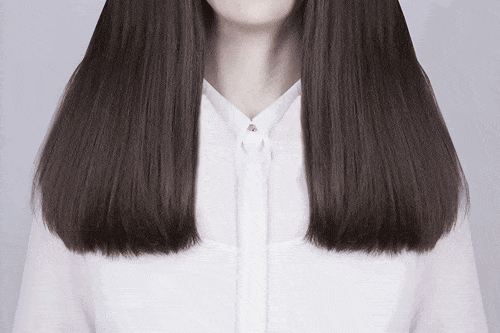Last minute, October 2024: new health risks lead the health authorities (Agence Nationale de Sécurité Sanitaire) to "advise against the use of these products". cf : https://www.ameli.fr/assure/actualites/alerte-sur-les-risques-lies-aux-produits-de-lissage-bresilien
HOW DOES IT WORK?
Chemical + thermo-mechanical action
This involves smoothing the hair, without altering its physical structure, by adding vegetable keratin and silicones to the hair's natural keratin and bonding them together. Specifically, the straightening product penetrates the cracks in the cortex, sinks into the crevices, repairs split ends and breaks, and glues it all together with formaldehyde or one of its derivatives, in the same way that plaster fills holes in a wall. The heated plates then fix the plant keratin and silicone, leaving the hair smooth and shiny.
Manipulation of hair keratin for Brazilian straightening
It is from its most intimate structure, that of the protofibrils of the keratin that you can change the natural colour or shape of your hair to dye it, curl it or, on the contrary, straighten it and make it smooth. For a Brazilian straightening or blow-drying with hot plates all that needs to be done is to break the weak links in the keratin and reconstitute them in a different way, using thermo-mechanical action. The resulting smoothing will be temporary, with the disulphide bridges remaining intact, forcing the hair to return to its natural shape, more or less quickly.

MAIN INGREDIENTS
- Plant keratin: wheat, rice, soya...
- Formaldehyde or one of its derivatives (e.g. methyl silicone)
- Acid glyoxylic
- Several parabens
- Several silicones
- Paraffin oil
- Alcohol
HAIR TYPES
Brazilian straightening can be used on all hair types: straight, wavy, curly, mixed race, frizzy, etc. on coloured, bleached, permed or straightened hair. However, it offers little or no effectiveness on very curly or frizzy hair.
APPLICATION
- Clarifying" shampoo to remove all impurities (silicones, dust, sebum, gel, spray, etc.).
- Apply the product with a brush on wet hair, strand by strand.
- Timer-controlled pause time - between 15 and 25 minutes, depending on the hair .
- Complete rinse .
- Brush blow-dry .
- Application of heating plates at 240° maximum.
Application time: 3 to 4 hours, depending on the density and length of the hair.
Then, as the formaldehyde continues to "work" for some time, the hair should not be wet (shampoo, rain, perspiration, swimming pool...) for 3 or 4 days, so that the product adheres well to the hair. During these few days, the hair should also not be tied up, or even styled behind the ears, as this will create bad creases.

Note: the ANSM has restricted the presence of formaldehyde in smoothing products to 0.2%, due to numerous clinical manifestations such as eye, respiratory or skin irritations, allergic reactions, etc.
RESULTS
The hair is not always as straight as the many video testimonials on the Internet claim. But it is relaxed, much softer and unsightly frizz is much reduced. If blow-drying is still necessary, it takes less time and is easier to do. As for the shine effect, obtained by closing the scales of the cuticle, it lasts as long as the straightening lasts.
LIFETIME
Brazilian formalin straightening is generally effective for 4 months. But the more often you wash your hair, the faster it fades. The composition of the shampoo is also important: we strongly advise you to use only very mild, pH-neutral products that contain no sodium laureth (or lauryl) sulphate.
As for formalin-free straightening, it lasts no longer than a month at the most.

